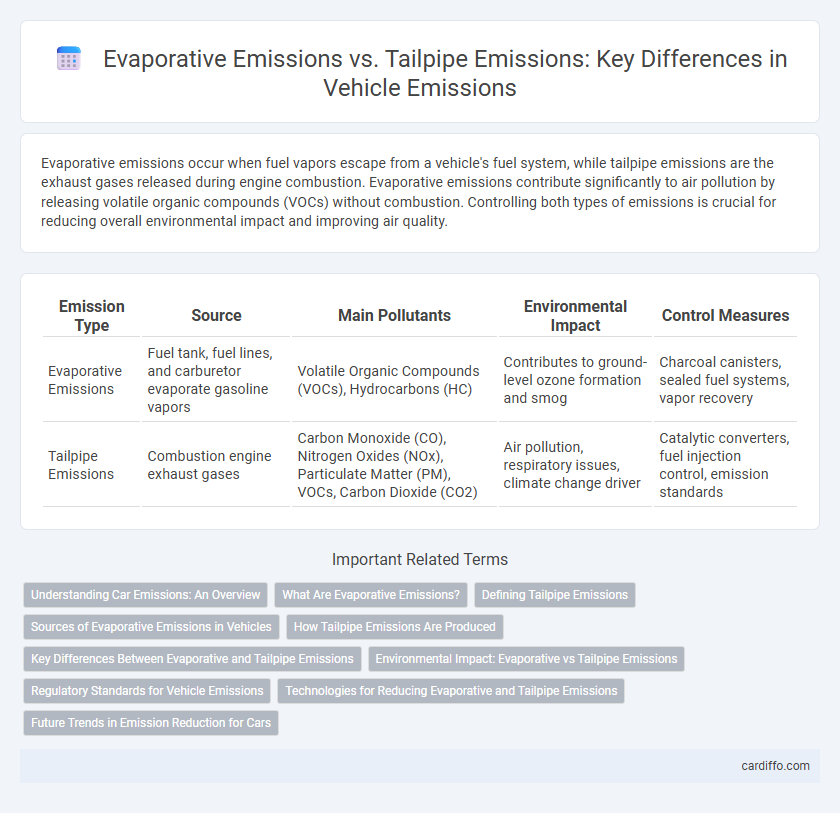Evaporative emissions occur when fuel vapors escape from a vehicle's fuel system, while tailpipe emissions are the exhaust gases released during engine combustion. Evaporative emissions contribute significantly to air pollution by releasing volatile organic compounds (VOCs) without combustion. Controlling both types of emissions is crucial for reducing overall environmental impact and improving air quality.
Table of Comparison
| Emission Type | Source | Main Pollutants | Environmental Impact | Control Measures |
|---|---|---|---|---|
| Evaporative Emissions | Fuel tank, fuel lines, and carburetor evaporate gasoline vapors | Volatile Organic Compounds (VOCs), Hydrocarbons (HC) | Contributes to ground-level ozone formation and smog | Charcoal canisters, sealed fuel systems, vapor recovery |
| Tailpipe Emissions | Combustion engine exhaust gases | Carbon Monoxide (CO), Nitrogen Oxides (NOx), Particulate Matter (PM), VOCs, Carbon Dioxide (CO2) | Air pollution, respiratory issues, climate change driver | Catalytic converters, fuel injection control, emission standards |
Understanding Car Emissions: An Overview
Evaporative emissions originate from fuel vapor leaks in a vehicle's fuel system, primarily during refueling or when the car is parked, contributing significantly to air pollution. Tailpipe emissions consist of exhaust gases released from the engine combustion process and contain pollutants like carbon monoxide, nitrogen oxides, and particulate matter. Understanding these two types of car emissions is crucial for developing effective emission control technologies and regulatory standards to reduce environmental impact.
What Are Evaporative Emissions?
Evaporative emissions refer to the release of fuel vapors from a vehicle's fuel system into the atmosphere without combustion. These emissions primarily occur from the fuel tank, carburetor, and fuel lines due to changes in temperature or pressure. Unlike tailpipe emissions, which result from engine exhaust, evaporative emissions contribute significantly to air pollution by releasing volatile organic compounds (VOCs).
Defining Tailpipe Emissions
Tailpipe emissions refer to the pollutants released directly from a vehicle's exhaust system during combustion, primarily consisting of carbon monoxide (CO), nitrogen oxides (NOx), hydrocarbons (HC), and particulate matter (PM). These emissions result from fuel burning in the engine and are a major contributor to urban air pollution and respiratory health issues. Controlling tailpipe emissions involves advanced engine technologies, catalytic converters, and stringent regulatory standards like the Euro 6 and Tier 3 programs.
Sources of Evaporative Emissions in Vehicles
Evaporative emissions primarily originate from fuel system components such as the fuel tank, carburetor, fuel lines, and evaporative canisters, where volatile organic compounds (VOCs) escape into the atmosphere. These emissions occur during refueling, vehicle operation, and while parked due to fuel vapor permeation and leakage. Controlling evaporative emissions requires advanced sealing technologies and vapor recovery systems to reduce VOC releases and improve air quality.
How Tailpipe Emissions Are Produced
Tailpipe emissions are produced during the combustion process within an internal combustion engine, where fuel and air mixture burns to generate power. This combustion releases pollutants such as carbon monoxide (CO), nitrogen oxides (NOx), particulate matter (PM), and unburned hydrocarbons (HC) directly through the vehicle's exhaust system. Unlike evaporative emissions, which arise from fuel vapor leakage, tailpipe emissions result from chemical reactions and temperature conditions inside the engine cylinders.
Key Differences Between Evaporative and Tailpipe Emissions
Evaporative emissions result from fuel vapor escaping the vehicle's fuel system, primarily from the fuel tank and carburetor, without combustion, while tailpipe emissions are produced by the combustion of fuel within the engine and released through the exhaust. Key differences include the chemical composition, with evaporative emissions predominantly composed of unburned hydrocarbons and tailpipe emissions containing carbon monoxide, nitrogen oxides, and particulate matter. Evaporative emissions contribute significantly to smog formation and are controlled by systems like the charcoal canister, whereas tailpipe emissions are regulated through catalytic converters to reduce harmful pollutants.
Environmental Impact: Evaporative vs Tailpipe Emissions
Evaporative emissions release volatile organic compounds (VOCs) directly into the atmosphere, contributing significantly to ground-level ozone formation and smog, which harms air quality and public health. Tailpipe emissions primarily emit carbon monoxide, nitrogen oxides, and particulate matter, driving respiratory issues and climate change through greenhouse gas accumulation. The environmental impact of evaporative emissions is often underestimated despite their persistent contribution to photochemical smog and urban air pollution.
Regulatory Standards for Vehicle Emissions
Regulatory standards for vehicle emissions strictly limit both evaporative emissions, which stem from fuel system vapors escaping during storage or operation, and tailpipe emissions that result from engine combustion. The Environmental Protection Agency (EPA) enforces Tier 3 standards combining limits on volatile organic compounds (VOCs) from evaporative sources and nitrogen oxides (NOx) and particulate matter from tailpipes to reduce smog and health risks. Compliance involves advanced technologies such as sealed fuel systems, activated carbon canisters for evaporative control, and catalytic converters for tailpipe emission reduction.
Technologies for Reducing Evaporative and Tailpipe Emissions
Advanced technologies for reducing evaporative emissions include improved fuel system designs like sealed fuel tanks and activated carbon canisters that capture fuel vapors before they escape into the atmosphere. Tailpipe emission control relies heavily on catalytic converters and oxygen sensors that optimize combustion efficiency and reduce pollutants such as CO, NOx, and hydrocarbons. Emerging solutions integrate onboard diagnostics and evaporative emission monitoring systems to ensure continuous compliance with stringent environmental regulations.
Future Trends in Emission Reduction for Cars
Future trends in emission reduction for cars emphasize advanced evaporative emission control systems alongside stricter tailpipe emission standards. Innovations such as enhanced carbon canisters and improved fuel system designs aim to minimize volatile organic compound (VOC) leaks, while tailpipe emissions benefit from next-generation catalytic converters and electrification technologies. Integrating electric and hybrid drivetrains significantly reduces both evaporative and tailpipe pollutants, aligning with global regulatory targets for greenhouse gas reductions and air quality improvements.
Evaporative Emissions vs Tailpipe Emissions Infographic

 cardiffo.com
cardiffo.com